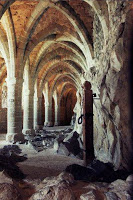 James over at Grognardia is about to launch his “Dwimmermount” campaign, and I wish him nothing but the best of luck with it. It did get me to thinking about the notion that an old school campaign should properly have a “megadungeon” as its tent-pole adventuring locale. James himself admitted that on reflection Greyhawk and Blackmoore were based on that idea, and it’s what led him to conclude that Dwimmermount would be a needed component of his own campaign.
James over at Grognardia is about to launch his “Dwimmermount” campaign, and I wish him nothing but the best of luck with it. It did get me to thinking about the notion that an old school campaign should properly have a “megadungeon” as its tent-pole adventuring locale. James himself admitted that on reflection Greyhawk and Blackmoore were based on that idea, and it’s what led him to conclude that Dwimmermount would be a needed component of his own campaign.
I happen to agree whole-heartedly, but it’s important to remember (as James has) that just because a campaign has a central megadungeon as its focus, it is by no means the exclusive province of the campaign. Adventurers are free to delve into its mouldy depths if they choose, but they’re just as free to poke around in the local town or city, hie off into the wilderness, or explore smaller dungeons that the DM should properly have waiting for those eager for a change of pace.
But what I think is important is that the tent-pole dungeon is there, for those days when the PCs weary of tracking down clues and following whatever plots they have been pursuing throughout the campaign. The tent-pole should, I think, be a sort of refuge from such things, existing in the world but not of it, a place where the PCs can set aside their plot-induced cares and just go someplace, kill things, and take their stuff. In my own campaign, the dungeon of Quasqueton served that purpose; when they needed to take a break from witches, brigands, and conspiracies the PCs would delve into its depths. It helped to bolster them in terms of x.p. and magic items, too, getting them to a place where they could more equally interact with some of the bad guys.
That doesn’t mean that the tent-pole needs to be 100% divorced from the rest of the campaign; surely NPCs encountered therein could be found elsewhere later (as the evil dwarf Obmi was in the original Greyhawk campaign), and actions in the dungeon could lead the stalwart PCs to other locales in the wilderness (the most famous example of this being, of course, the fact that those who made it to the lowest level of Castle Greyhawk were sent to the other side of the world and left to make their way home via an extended wilderness trek). Items needed in the broader campaign might be found in the dungeon (special magical items, for instance, or even a piece of vital intelligence regarding a personage or locale), necessitating a trip into the megadungeon to retrieve it. The megadungeon needn’t exist in a vacuum.
It should also be remembered that the campaign tent-pole need not be a conventional mega-dungeon. Certainly that’s one of the easiest, and most commonly found, devices, but a little brainstorming can provide some other ideas that serve the same purpose.
- The ruined city. If you decide to go with the notion that the players should have at least a rough idea of how tough the territory is (as with the megadungeon idea that lower levels = harder monsters), you could have lower level encounters closer to the walls, getting more difficult as the PCs get towards the central palace.
- The haunted forest. A maze of twisting forest paths through the underbrush, with clearings, large tree-houses, streams and ponds, etc. filling the role of corridors and rooms. If the PCs dare, they could try to hack through the dense underbrush, but at the risk of getting lost and disturbing the really dangerous things that live off the paths and trails.
- The depths. Rather than a single megadungeon, the PCs forray into the vast underground realms known in some places as the Underdark, Depths of the Oerth, the Wormroad, etc. The essential difference is that miles of caves and tunnels separate encounter areas, some of which could count as dungeons unto themselves, others of which are more modest. The strains upon the PCs are greater, as the logistical challenges of negotiating a miles-long dungeon are necessarily tougher than a megadungeon contained within a fairly compact area. Entrance and egress could be interesting problems as well.
- The uncharted wilds. A “standard” wilderness should never be discounted as a possible tent-pole adventure locale, as long as it is built up as such. Though it may be spread out over many miles, a specific wilderness could fit the bill nicely. Punctuated with small ruins and dungeons, varying sorts of terrain giving rise to very different encounters, the sort of thing the legendary West Marches campaign was built on. I would only change things inasmuch as there would be adventures to be had in the town, and of a different nature in the more civilized areas, but the call of the wilderness would always be there and available.
- The Infinite Planes. Here’s something I’m not sure I’d ever have the balls to try to pull off, because it would take a LOT of prep-work, but if you did it right it could be the stuff of legends. Give the PCs access to something akin to the Codex of the Infinite Planes. Each adventure is a jaunt to another plane, or demi-plane, or even epoch. One day they find themselves in the far future, the next in Willie Wonka’s chocolate factory, and the next dodging sleestaks and t-rexes. The trick would be to keep it fresh and interesting every time; you don’t want to wing this one. One trip to “the infinite desert of nothing notable”, while it might make the end of a spiffy Twilight Zone episode, could spell the end of an RPG campaign.
- The sewers. Who’s to say the PCs even have to leave the walls of the home city? I once did a game where the dungeon was the sewers. In practice it’s little different from a standard mega-dungeon, but the key is that there can be a LOT more connection with the PCs supposedly safe home base. Every building has a cellar, and many of those have secret doors leading to sub-basements and hooking up with the sewers. Hidden temples, an entire zone of crypts and tombs, thieves and assassins who use the sewers as a highway and think they know what’s going on, but in reality they only know but a smidgen of what’s going on beneath the streets… This is a nice way to combine intrigue and the mega-dungeon directly.
Just some thoughts to get the ol’ creative juices flowing. There are hundreds of possibilities.












it’s important to remember (as James has) that just because a campaign has a central megadungeon as its focus, it is by no means the exclusive province of the campaign. Adventurers are free to delve into its mouldy depths if they choose, but they’re just as free to poke around in the local town or city, hie off into the wilderness, or explore smaller dungeons that the DM should properly have waiting for those eager for a change of pace.
Totally agree. The megadungeon is the classic campaign centerpiece, but it has to be at the center of something.
Man, you are full of good ideas. I had never thought of just treating a forest as a dungeon, and have always been disturbed by playing in them. It usually looks better during prep. One of the hardest things for me is actually leaving the dungeon, once the objective is obtained. I’m terrible! Even if we have a few hours left over I just start minimizing everything. I suppose that the transition is the problem. Moving from a nice closed environment, were I can easily keep 2 or 3 steps ahead of the players, to all of that open space!
Just a little more thought on the forest; imagine at the very darkest heart of the wood a gnarled, thousand-year-old tree as the very heart of the darkness that infests the whole forest. Very hard to get to, with no trails or paths leading there, requiring the forest-equivalent of a passwall spell to even reach, and months if not years of research and exploration to figure out where the place even is.
I really like this idea of a mega-dungeon. I will also admit when James first mentioned it several months ago, I started the process of adding to my next campaign. I was going to run a straight AP, but now, I have changed it up a bit and I am going to run a hybrid campaign that will include both an AP and a Mega-dungeon. I am still working on the details on how this is going to fit together.